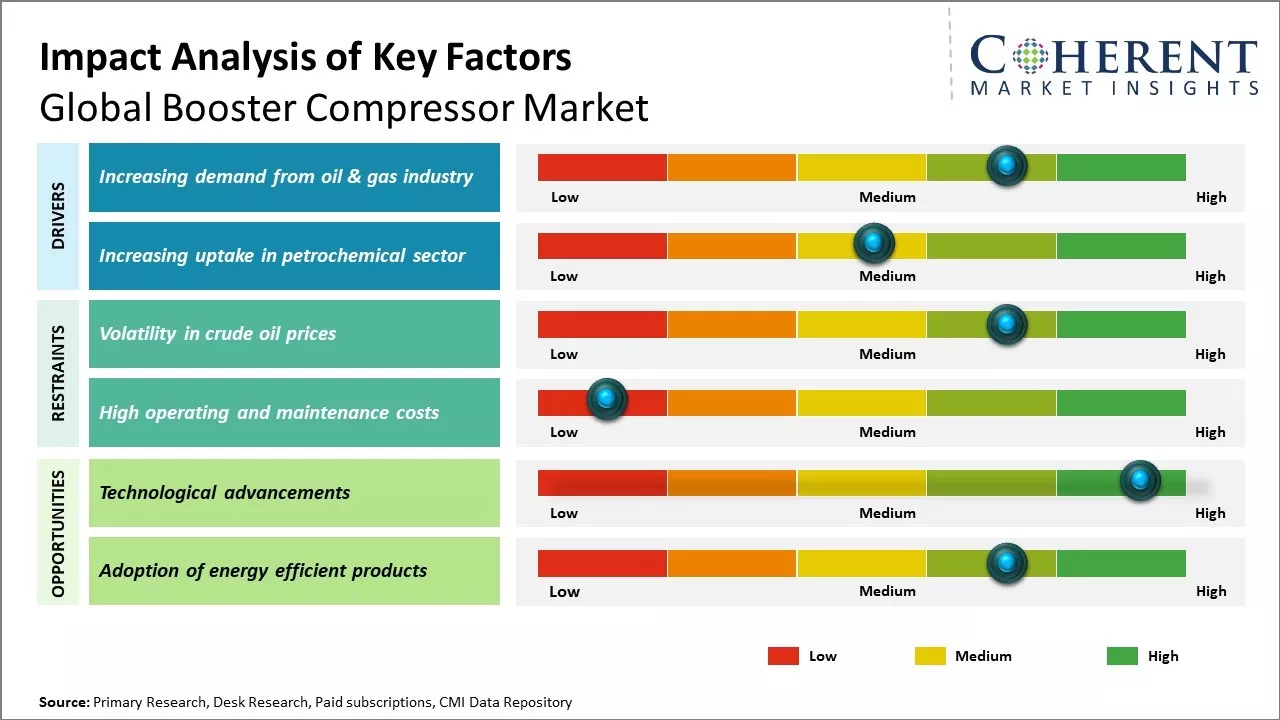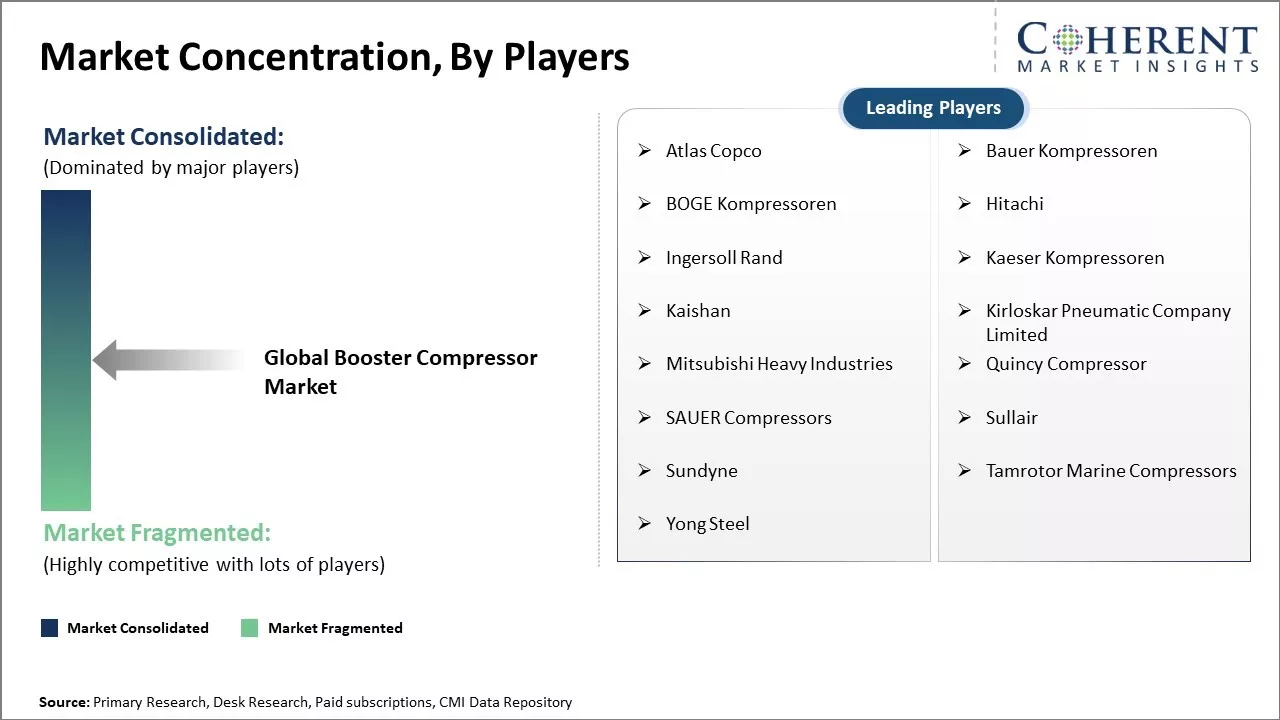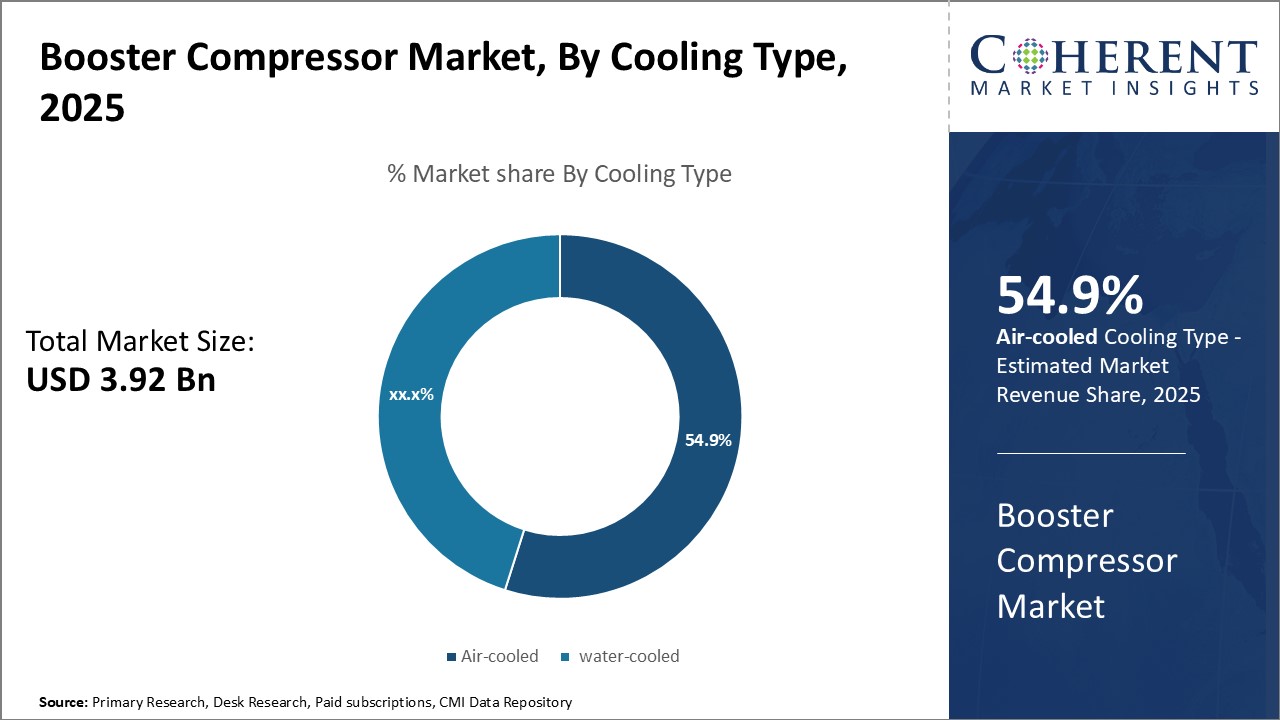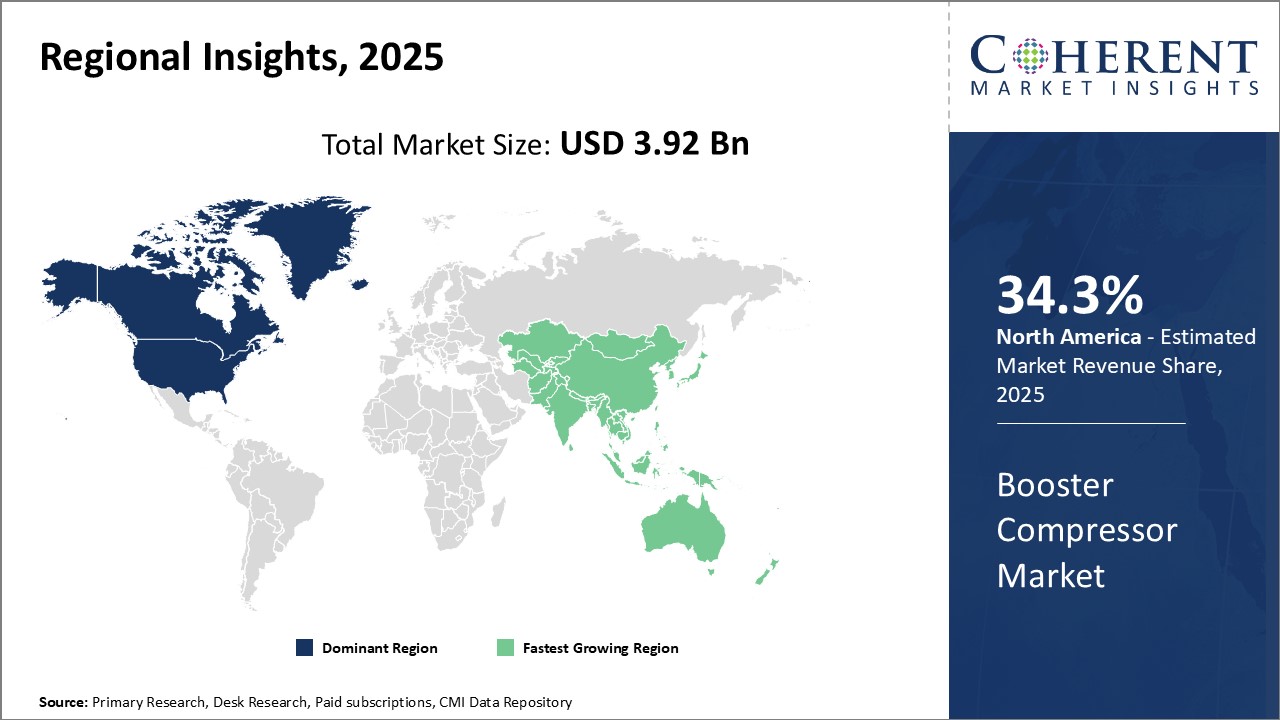The Global Booster Compressor Market is estimated to be valued at US$ 3.92 Bn in 2025 and is expected to reach US$ 5.45 Bn by 2032, exhibiting a compound annual growth rate (CAGR) of 4.8% from 2025 to 2032.

Discover market dynamics shaping the industry: Download Free Sample
The market is witnessing positive trends mainly due to increasing demand from industries such as oil & gas, petrochemical, and power generation. The growing energy demand across the globe especially in emerging countries of Asia Pacific and Middle East Africa is driving the demand for booster compressors from these industries. Additionally, the surging need for compressed natural gas (CNG) as an alternative fuel for automobiles and the growing focus towards reducing greenhouse gas emissions are expected to propel the global booster compressor market during the forecast period. With continuous capacity additions in process industries and rising energy demand worldwide, the booster compressor market is expected to grow substantially in the coming years.
Increasing demand from oil & gas industry
The oil and gas industry relies heavily on boosting compressor to aid in extraction and transportation of oil and natural gas. Boosters are used at various points along the production cycle from initial extraction from wells to processing facilities and transportation through pipelines over long distances. With rising energy needs globally, oil and gas production has been increasing steadily each year. This consistent rise in oil and gas output will certainly fuel the growth of boosting compressor market that caters specifically to upstream and midstream operations of oil and gas industry.
Further, with depletion of onshore reserves, exploration and drilling activities are moving to offshore and deep-water reserves which pose additional technical challenges. Deep-sea oil rigs and ultra-long undersea pipelines driving offshore production require high-capacity boosting equipment to maintain requisite pressure over extended periods. Leading oil producers have been making huge capital investments in developing untapped reserves in locations like Arctic region and unlocking energy from shale rocks and oil sands also necessitate deployment of specialized booster compressors. As oil and gas industry expands into newer frontier areas in the pursuit of energy security, demand for high-performing and durable booster compressors tailored for tough operating conditions is likely to grow substantially.

Get actionable strategies to beat competition: Download Free Sample
Increasing uptake in petrochemical sector
Another key end-use industry augmenting the booster compressor market growth is petrochemicals. Petrochemical sector constitutes an integral part of the global energy and manufacturing industry which uses oil and gas as primary feedstock to produce important chemicals, plastics and synthetic materials. Rapid industrialization and surging consumption of petrochemical-based products across the world has been propelling capacity additions in petrochemical plants. Since these facilities depend on processed hydrocarbons as raw materials, deployment of booster compressors is important at various stages right from gas processing terminals to complex manufacturing sites for operations like steam cracking, distillation and polymerization.
Rising petrochemical trade flows owing to globalization is also elevating the relevance of boosting compressors in LNG terminals and import-export pipelines. The market is further gaining traction from capacity ramp-ups in emerging petrochemical hubs to meet the soaring demand from construction, automotive and packaging sectors in developing economies.
Key Takeaways from Analyst:
The global booster compressor market is expected to witness steady growth over the forecast period driven by increasing demand from the oil & gas industry. Boosters are essential equipment for pumping hydrocarbon fluids across pipelines and processing facilities. With rise in global energy demand and new oil and gas field development projects, requirement of boosters is set to increase substantially. Expanding natural gas distribution and transportation infrastructure especially in developing nations will further spur market opportunities.
However, volatility in crude oil prices poses a major challenge to investments in new projects. Uncertainties associated with energy policies and regulations globally could also negatively impact market demand. Shift towards renewable sources of energy may reduce reliance on conventional sources in long run.
The Asia Pacific region is projected to be the fastest growing market for booster compressors due to ongoing infrastructure expansion in countries like China and India. High economic growth and urbanization are driving extensive pipeline networks for city gas distribution in the region. North America will continue to be a key market underpinned by extensive pipeline assets and increasing production from shale plays. Countries like Saudi Arabia, UAE, Iran and Qatar are dominating the Middle Eastern market owing to their role as leading oil and gas producers.
Overall, steady investments planned in pipeline and processing facilities across major producers indicate healthy demand prospects for booster compressor manufacturers.
Market Challenges: Volatility in crude oil prices
The volatility in crude oil prices has significantly restrained the growth of the global booster compressor market in recent years. When crude oil prices fluctuate substantially, it creates uncertainty in the global energy industry. The booster compressor market is closely tied to the oil and gas sector as these machines are extensively used to boost the pressure in oil and gas pipelines during production, refining and transportation activities. Unpredictable swings in crude prices discourage large capital investments in the infrastructure and machinery required for exploration and production activities.
Market Opportunities: Technological advancements
Technological advancements are empowering the global booster compressor market with significant opportunities. Compressors are becoming more automated, remote-controlled and IoT-enabled which is improving productivity and reducing operational costs significantly for end users. For example, many modern booster compressors now come equipped with smart sensors that monitor critical parameters like temperature, pressure and vibrations continuously. They can transmit this critical operational data to controllers in real-time using built-in wireless or wired connectivity. This enables remote monitoring and predictive maintenance of compressors without needing on-site inspection. As a result, downtime is minimized and maintenance is more planned and efficient.

Discover high revenue pocket segments and roadmap to it: Download Free Sample
Insights By Cooling Type - Reliability and efficiency drive demand for air-cooled boosters
In terms of cooling type, the air-cooled segment is expected to hold 54.9% share of the market in 2025 owing to their inherent reliability and efficiency advantages over water-cooled boosters. Air-cooled boosters have fewer moving parts and therefore require less maintenance than water-cooled models. Since they do not recirculate cooling water, they are less prone to issues like corrosion, leaks, and mineral buildup that can reduce the lifespan of water-cooled boosters. This simple and reliable design allows air-cooled boosters to achieve high uptime and require less downtime for maintenance, lowering operating costs for end users. They also achieve comparable cooling performance without the ancillary equipment needed to circulate water. This reduces both capital and installation expenses compared to water-cooled boosters. Their straightforward design also makes air-cooled boosters better suited for use in remote or harsh environments where water supply and drainage infrastructure may be limited.
Insights By Compression Stage - Dependability across diverse applications drives preference for double stage compression
In terms of compression stage, the double stage segment is expected to hold 49.6% share of the market in 2025 due to its ability to reliably compress a wide range of gases for diverse industrial applications. Double stage compression allows boosters to develop higher final pressures than single stage models by splitting the compression work between two stages. This depends push gases to required delivery pressures in industries like manufacturing and petrochemicals that demand consistent flows of compressed air or gases. It also reduces heat generation and stress on components compared to single stage compression for high-pressure applications. The modular design of double stage boosters also makes them flexible for varying flow needs. Their stable performance across a variety of gases and operating pressures makes double stage boosters the preferred option when dependable compression is required to support multiple production processes.
Insights By End User - Critical gas compression drives concentration in oil and gas industry
In terms of end user, the oil and gas segment are expected to hold 42.1% share of the market in 2025 due to its dependence on booster compressors to optimize upstream and downstream processes. In the upstream sector, boosters are crucial for injection applications that enhance oil recovery from mature fields. They are also used to compress natural gas for pipeline transmission and processing. In downstream refining and petrochemical operations, boosters ensure steady feed gas pressures for furnaces, reactors and other process equipment. Considering the capital intensity of oil and gas projects, reliability of gas compression is paramount. Booster compressors tailored for the demanding specifications of oilfield gases and varying wellhead pressures give midstream and production operators a suitable solution. Their role in maximizing asset productivity throughout the hydrocarbon value chain cements boosters as indispensable to the industry.

Need a Different Region or Segment? Download Free Sample
The North American region currently dominates the global booster compressor market. The region is expected to account for 34.3% of the market share in 2025. The region accounts for the largest share of the market due to strong presence of major oil and gas companies in countries like the U.S. and Canada. With abundant shale gas reserves, the demand for boosting gas pressure during extraction and transportation processes is considerably high. This ensures steady requirements for booster compressors from upstream and midstream oilfield service providers.
The industrial sector is another major consumer of booster compressors in North America owing to widespread manufacturing activities. Many industrial plants utilize boosters to increase pressure of gases in various processing stages. Leading compressor manufacturers have established production bases as well as strong distribution networks catering to regional demand. Furthermore, the export of booster compressors from North America is significant owing to technology advancement and adherence to stringent quality standards.
The Asia Pacific region has emerged as the fastest growing market for booster compressors globally. Countries like China, India, Indonesia, and Malaysia are expected to be at the forefront of demand growth. Considering the expanding chemical processing, refining, and steel industries, the use of boosters is increasing substantially. The expanding gas pipeline infrastructure for city gas distribution is another key growth driver.
Rising urbanization and focus on switching to cleaner fuels have ramped up investments in developing domestic gas reserves and import facilities in Asia Pacific. This, coupled with efforts towards boosting industrial output, is propelling the regional need for boosting gas pressure during transport and processing. The presence of cost-competitive compressor manufacturers encourages plants to invest in productivity increase via automation and process intensification using boosters. Favorable government policies and low input costs are attracting foreign investments as well, strengthening the Asia Pacific position as a leading consumer base.
Booster Compressor Market Report Coverage
| Report Coverage | Details | ||
|---|---|---|---|
| Base Year: | 2024 | Market Size in 2025: | USD 3.92 Bn |
| Historical Data for: | 2020 To 2024 | Forecast Period: | 2025 To 2032 |
| Forecast Period 2025 to 2032 CAGR: | 4.8% | 2032 Value Projection: | USD 5.45 Bn |
| Geographies covered: |
|
||
| Segments covered: |
|
||
| Companies covered: |
Atlas Copco, Bauer Kompressoren, BOGE Kompressoren, Hitachi, Ingersoll Rand, Kaeser Kompressoren, Kaishan, Kirloskar Pneumatic Company Limited, Mitsubishi Heavy Industries, Quincy Compressor, SAUER Compressors, Sullair, Sundyne, Tamrotor Marine Compressors, and Yong Steel |
||
| Growth Drivers: |
|
||
| Restraints & Challenges: |
|
||
Uncover macros and micros vetted on 75+ parameters: Get instant access to report
*Definition: The Global Booster Compressor Market involves the manufacturing and sales of booster compressor systems. These systems are used to increase the pressure of pneumatic equipment, machinery or processes by compressing gases to higher pressures than what a single compressor or pump can achieve alone. They help boost the existing line pressure or supplement the capacity of existing compressors. Major end-use industries of booster compressor systems include oil & gas, mining, manufacturing, and others where high-pressure gases are required for operation.
Share
Share
About Author
Ramprasad Bhute is a Senior Research Consultant with over 6 years of experience in market research and business consulting. He manages consulting and market research projects centered on go-to-market strategy, opportunity analysis, competitive landscape, and market size estimation and forecasting. He also advises clients on identifying and targeting absolute opportunities to penetrate untapped markets.
Missing comfort of reading report in your local language? Find your preferred language :
Transform your Strategy with Exclusive Trending Reports :
Frequently Asked Questions
Joining thousands of companies around the world committed to making the Excellent Business Solutions.
View All Our Clients